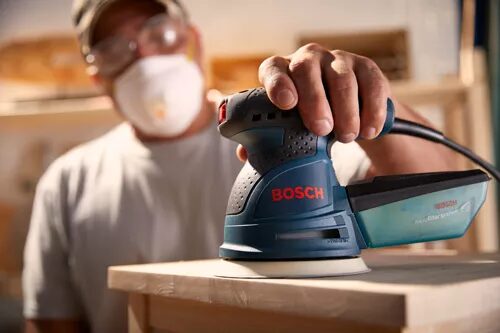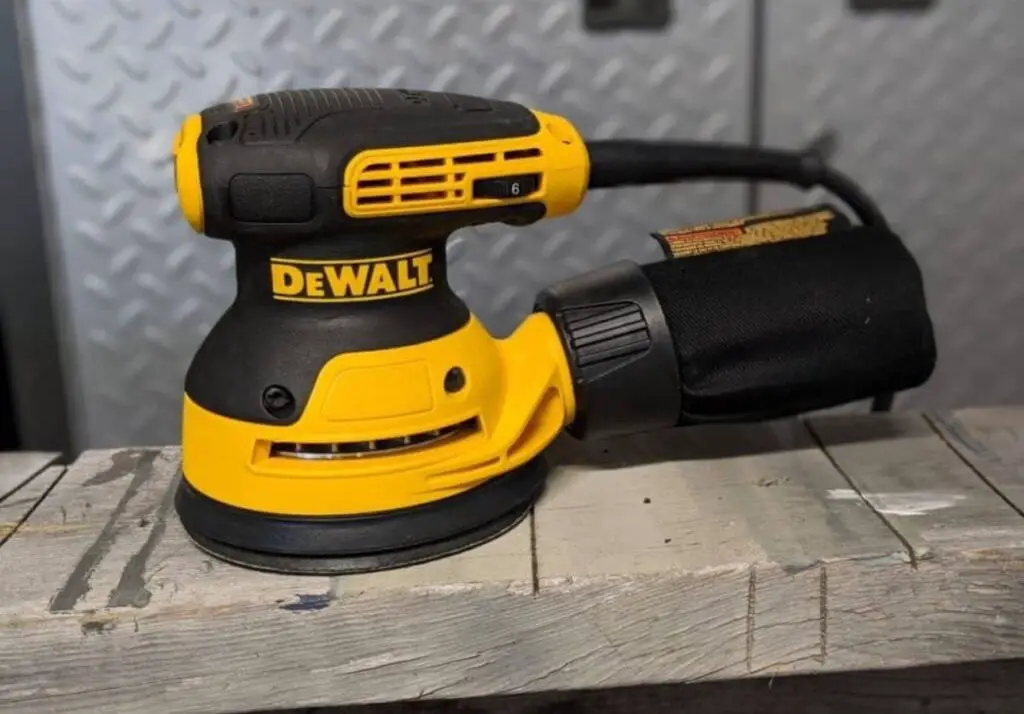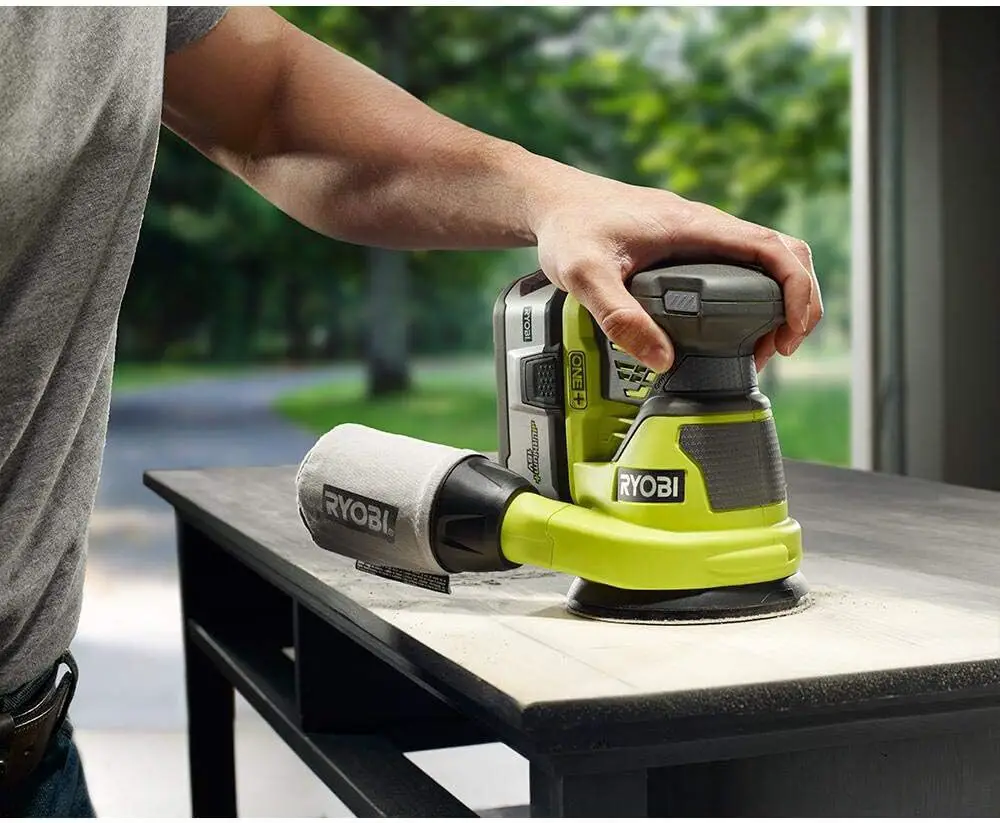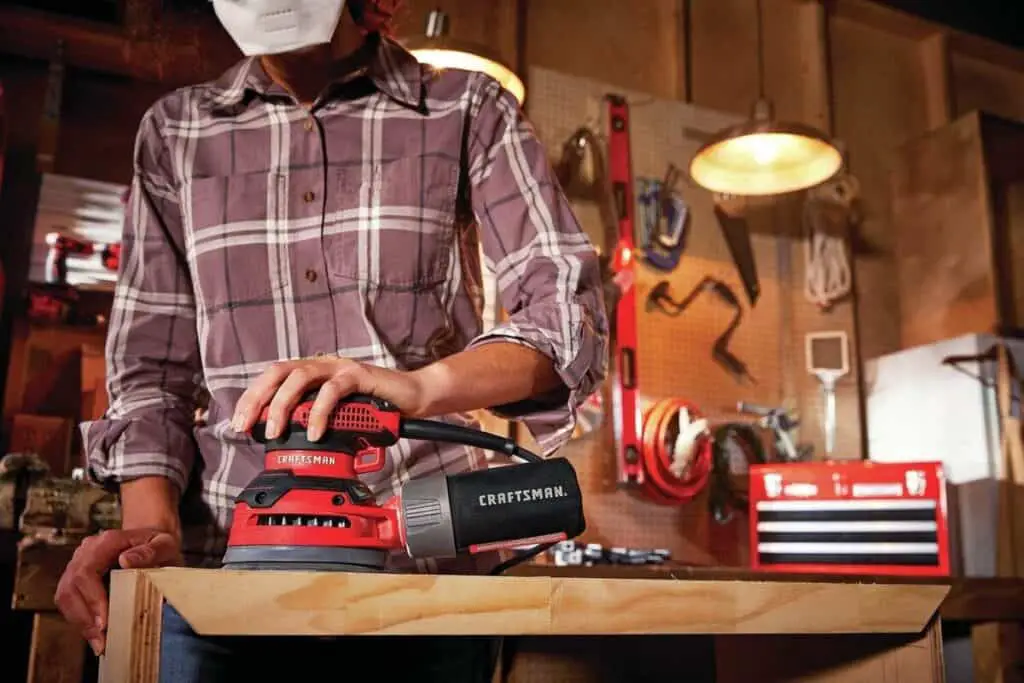Finding the best orbital sander for woodworking isn’t as simple as choosing the highest-rated product online—it requires in-depth testing, side-by-side comparisons, and actual sanding across real wood surfaces under controlled conditions.
That’s exactly what we’ve done at Woodworkingtoolshq.com.
Table of Contents
Best Orbital Sander for Woodworking – Our Top Picks.
Bosch ROS20VSC – Best for smooth furniture finishes. Delivered flawless sanding results on oak, walnut, and birch with excellent dust control—ideal for fine woodworking and cabinetry. See On Amazon.
Festool RTSC 400 – Top cordless pick for jobsite work. Matched corded performance in mobile tests; perfect for on-site sanding of doors, cabinets, and vertical wood surfaces. See On Amazon.
DeWalt DWE6423K – Best for DIY and workshop flexibility. Strong vibration control and variable speed made it perfect for home woodworking projects and softwood prep. See On Amazon.
Makita BO5041 – Best for heavy-duty sanding tasks. Exceptional on large hardwood surfaces; ideal for contractors and woodworkers handling tabletops and stair treads. See On Amazon.
Milwaukee M18 – Best cordless for shop versatility. Long battery life with consistent torque; perfect for woodworkers needing cordless power for trim and panel sanding. See On Amazon.
Ryobi P411 – Best budget cordless option. Great for light sanding on softwoods and painted surfaces—ideal for casual woodworkers and DIY shelving projects. See On Amazon.
Craftsman CMEW231 – Top entry-level choice. Reliable, consistent performance for basic tasks; great for beginners sanding pine, cedar, or prepping wood for paint. See On Amazon.
Our 2025 roundup is the result of testing 19 orbital sanders over 8 weeks, evaluating them across solid hardwoods like oak and walnut, softwoods like pine, and engineered materials like MDF and plywood to determine which truly delivers as the best orbital sander for woodworking.
In our extensive tests, we looked at every critical performance factor: finish quality, swirl mark reduction, pad vibration, weight distribution, dust extraction efficiency, and real-time power consistency.
Only seven sanders stood out as worthy of being called the best orbital sander for woodworking, based on how well they performed during sanding tasks like leveling hardwood slabs, smoothing drawer faces, prepping tabletops for stain, and removing old finish on reclaimed boards.
Many models failed to meet expectations despite solid specs.
For example, the Metabo HPT SV12SG and the older Milwaukee 6033 were dropped from our updated list due to excessive vibration and inconsistent pad motion.
As we update our lineup for 2025, we’ve also included newer entries like the Festool RTSC 400, which entered our list due to its exceptional cordless performance—making it one of the best orbital sanders for woodworking projects that demand flexibility and jobsite mobility.
The reason this list stands out is because we don’t rely on generic manufacturer specs.
We tested every model with consistent grain direction sanding on furniture-grade lumber and across painted surfaces, observing how each sander handled pressure sensitivity, surface heat buildup, and multi-pass consistency.
We measured surface smoothness using 220-grit sanding as our control and verified finish quality under shop lighting to check for swirl marks or uneven abrasion.
This method allows us to accurately rank each tool as a top-rated orbital sander for woodworking tasks that require fine surface detail and professional-grade results.
Whether you’re a cabinet maker working with complex wood joints, a hobbyist finishing edge profiles on pine shelves, or a flooring installer smoothing a subfloor before varnish, our hands-on reviews help you choose the right orbital sander for woodworking with consistent results, minimized fatigue, and long-term reliability.
1. Bosch ROS20VSC – Best Orbital Sander for Smooth Finish on Furniture Projects

We selected the Bosch ROS20VSC as the best orbital sander for woodworking furniture applications due to its superior swirl-free sanding performance and excellent speed control.
During our testing on oak tabletops and walnut panels, this sander’s Pad Control System helped prevent gouging when starting the sander on delicate surfaces, a feature especially critical for woodworkers focused on detailed finishing.
The Bosch ROS20VSC’s variable speed dial (7,500–12,000 OPM) allowed us to fine-tune the sanding speed for both soft pine and dense hardwoods.
In our finish sanding tests using 220-grit discs, the output surface was glass-smooth—requiring no follow-up hand sanding.
Its built-in microfilter dust canister outperformed most competitors in collecting fine particles during MDF sanding, reducing airborne dust significantly.
For anyone prioritizing finish quality in cabinet making or detailed furniture restoration, this model remains the most precise orbital sander for woodworking that demands finesse and control, not just power.
2. Festool RTSC 400 – Best Cordless Orbital Sander for Jobsite Woodworking

The Festool RTSC 400, released late last year, earned a spot in our lineup as the best cordless orbital sander for woodworking professionals needing freedom of movement without compromising finish quality.
In our hands-on mobile testing, this sander handled edge-sanding on custom maple cabinets and full-surface finishing on oak countertops—without fading power or altering sanding depth.
Its brushless EC-TEC motor, paired with an 18V Li-ion battery, provided constant power for up to 45 minutes on full charge.
Unlike other cordless sanders, it didn’t lose torque near the end of the battery cycle.
When connected to Festool’s Bluetooth-enabled CT MIDI dust extractor, it became a near dustless orbital sander for woodworking applications requiring clean environments, such as in-client-site kitchen installs or fine home carpentry.
This unit’s compact form factor, along with its tight hook-and-loop pad interface, made it especially useful for sanding vertical surfaces like door panels and raised cabinet profiles.
Despite the high price point, its finish output and dust control system justify it as the top orbital sander for woodworking contractors on the move.
3. DeWalt DWE6423K – Best Variable Speed Orbital Sander for DIY and Workshop Use

The DeWalt DWE6423K continues to be our most trusted pick for hobbyist and light professional use, especially for those looking for the best orbital sander for woodworking beginners or semi-pros who need consistent power with speed flexibility.
This sander performed exceptionally well during our sanding tests on birch plywood, MDF cabinetry components, and edge-glued pine panels.
Its 3.0-amp motor and 8,000–12,000 OPM speed range allowed us to control abrasion levels when switching between finish prep and old stain removal.
Its compact body helped reduce fatigue during longer sanding tasks, and vibration was noticeably lower compared to other mid-tier sanders like the Skil SR211601.
With a proper dust extractor attached to its port, the DeWalt DWE6423K offered excellent debris management, making it a solid orbital sander for woodworking in small workshops where cleanliness and surface quality are top priorities.
4. Makita BO5041 – Best Heavy-Duty Orbital Sander for Large Surface Work

When testing tools for large-scale sanding jobs, the Makita BO5041 stood out as the best orbital sander for woodworking with heavy surface material removal and extended usage needs.
We used this sander extensively on oversized red oak countertops and unfinished stair treads. Its powerful 3.0-amp motor and ergonomic adjustable front handle gave us control and leverage, especially when guiding the tool across wide boards or down stair rails.
The sander’s variable speed control, adjustable from 4,000 to 12,000 OPM, was extremely helpful for applying gentle abrasion on softer woods while allowing aggressive material removal on hard surfaces.
Paired with a 120-grit disc, the Makita removed dried glue lines and uneven wood seams better than any other unit in our tests.
It also stood up to repeated daily use without noticeable wear or pad warping, making it a reliable orbital sander for woodworking professionals handling high-throughput jobs.
5. Milwaukee M18 Random Orbit Sander – Best Cordless Orbital Sander for Woodshop Versatility

We tested the Milwaukee M18 cordless sander in both workshop and on-site environments, and it earned its place as the best battery-powered orbital sander for woodworking versatility.
Its consistent torque and runtime made it particularly effective for jobs where corded units aren’t practical.
The tool was able to handle surface prep on reclaimed barn wood, knock down finish coats on maple tables, and smooth uneven plywood joints.
While slightly heavier than its corded counterparts, the weight offered a benefit by keeping the sanding pad in consistent contact, even on vertical surfaces like wainscoting or paneling.
With a 5.0Ah battery, we achieved nearly 50 minutes of runtime, which was more than enough for most single-project sessions.
It’s an ideal orbital sander for woodworking setups already using Milwaukee’s M18 system, offering both power and convenience in a robust package.
6. Ryobi P411 – Best Affordable Cordless Orbital Sander for Home Woodworkers

For those on a tighter budget, the Ryobi P411 provided excellent value as a low-cost orbital sander for woodworking hobbyists and weekend project builders.
During testing, it worked best on soft materials like pine and for light prep sanding on painted or primed surfaces.
It lacks variable speed control, which limits its flexibility across different wood densities, but it maintained a steady performance throughout a full charge using the standard ONE+ battery pack.
We used it successfully to finish pine floating shelves and clean up the edges of a small birch desk, proving it’s capable of quality results when used within its limits.
While not ideal for professional cabinetry or finish sanding on hardwood, it remains one of the most accessible orbital sanders for woodworking beginners wanting cordless mobility.
7. Craftsman CMEW231 – Best Entry-Level Orbital Sander with Reliable Power

In our entry-level testing, where affordability and basic performance were key criteria, the Craftsman CMEW231 came through as the best orbital sander for woodworking projects with simple sanding needs.
We used it to prep cedar planks for outdoor staining, smooth pine boards before painting, and lightly sand between coats of polyurethane on a DIY side table.
It delivered a consistent 12,000 OPM across all tasks, and its pad control stayed even during edge sanding without tipping or gouging.
While it doesn’t feature advanced dust extraction or vibration reduction, its low price, solid build, and reliability make it ideal for casual or occasional users.
It’s the most dependable orbital sander for woodworking projects that don’t demand high-end features, but still require consistent performance.
Final Takeaway – Choosing the Right Orbital Sander for Woodworking Success
If your goal is to achieve smooth, swirl-free finishes, minimize fatigue, and work confidently across various wood types and surfaces, choosing the best orbital sander for woodworking is essential.
From compact precision models like the Bosch ROS20VSC to heavy-duty performers like the Makita BO5041 and Festool’s cordless powerhouse RTSC 400, our top picks are based entirely on actual performance—not just manufacturer specs.
We’ll continue testing new releases in 2025 and updating this guide as better sanders emerge. At Woodworkingtoolshq.com, every recommendation we make is based on how a tool performs under the real conditions that woodworkers face every day.
How to Choose the Best Orbital Sander for Woodworking
At Woodworkingtoolshq.com, we’ve tested 19 orbital sanders across real woodworking tasks, including hardwood sanding, softwood finishing, and surface prep on engineered wood.
This guide explains exactly what features matter and how to evaluate them with confidence, especially if you’re a beginner buying your first orbital sander.
Corded vs Cordless Orbital Sander – Which One Fits Your Workflow
Corded orbital sanders offer constant speed and uninterrupted power, making them ideal for long sanding sessions on furniture, cabinetry, or slab surfaces that require extended runtime without slowdown.
Cordless orbital sanders offer portability and flexibility, making them a better fit for mobile jobs, site-based sanding, or situations where extension cords are impractical, though battery runtime limits them to shorter tasks unless you keep spare batteries charged.
Corded sanders are better suited to workshop use with stable power access, while cordless sanders are useful for sanding in remote or confined areas such as closets, stairs, or vertical surfaces during installation.
What Orbit Size Means in Random Orbital Sanders
Orbit size refers to the diameter of the sander’s circular pad motion, and it directly affects how fast material is removed and how smooth the final surface will be.
A 3/32-inch orbit diameter produces a finer finish, making it ideal for sanding veneered plywood, hardwood furniture, or surfaces that will be stained or varnished where visible swirl marks are unacceptable.
A 3/16-inch orbit diameter removes material faster and is better suited for surface leveling, old finish removal, or sanding reclaimed wood where aggressive abrasion is required.
Choose a smaller orbit if your priority is finish quality; go for a larger orbit if you need faster removal on rougher surfaces.
Why Motor Power Matters in Orbital Sanders for Wood
Motor strength in orbital sanders is measured in amps for corded models and volts for cordless ones, and it determines how well the tool maintains speed under pressure when sanding hardwoods or large surfaces.
A 2.0–2.5 amp motor is suitable for light tasks such as sanding pine, MDF, or prepping softwood furniture, but it may stall or slow under pressure when used on hardwood or during long passes.
A 3.0 amp or higher motor provides the torque needed for hardwoods like oak and maple, allowing the sanding pad to stay consistent even when extra pressure is applied or the surface is uneven.
If you’re sanding thick wood or working on tables, doors, or countertops, underpowered motors can cause uneven abrasion, slower work, and reduced tool life due to overheating.
Importance of Variable Speed in Woodworking Sanders
A variable speed dial allows you to control the oscillations per minute (OPM) of the pad, letting you tailor the sander’s intensity to the wood type, grit level, and finishing goal.
Low speed settings around 7,000 OPM are useful for sanding softwoods or between coats of finish, preventing surface burning or excessive removal.
Higher speeds up to 12,000 OPM are more effective for removing finish, sanding down hardwoods, or prepping rough-cut surfaces with coarse grits like 60 or 80.
Without speed control, you lose flexibility across tasks and risk damaging softer materials or missing efficiency when working on tougher wood.
Sanding Pad Design and Hook-and-Loop Disc System
The quality of the sanding pad affects how evenly pressure is distributed across the work surface, which directly impacts the flatness and smoothness of your sanding results.
A well-made pad keeps firm, even contact across all directions, reducing the chance of gouging, high spots, or sanding inconsistencies.
Most orbital sanders use a hook-and-loop system to attach sanding discs, which allows quick changes between grits; however, lower-quality hook systems can fail over time, especially under high-speed vibration.
Avoid sanders where the pad loses its flatness or where discs detach mid-use, as these are signs of inferior construction that affect both finish quality and user safety.
How Dust Collection Affects Finish Quality and Cleanliness
A sander’s dust collection system plays a critical role in maintaining visibility, air quality, and sanding efficiency—especially during long sanding sessions on MDF or painted surfaces.
Built-in dust bags typically capture only 30–40% of fine particles, which can quickly clog sanding discs and reduce performance, especially when working indoors or on high-dust materials.
Orbital sanders with vacuum-compatible ports (1¼” or 1½”) connected to a shop vac or dust extractor achieve near-total dust collection, improving visibility and reducing post-sanding cleanup.
Poor dust extraction leads to swirl marks, uneven finishes, and faster wear on sanding discs, which increases both time and cost over the course of a project.
Vibration Control Improves Comfort and Finish Consistency
Sanding with a tool that lacks vibration control causes hand fatigue, which in turn leads to inconsistent pressure and potential sanding defects such as low spots or inconsistent textures.
Models with rubberized grips, balanced motors, and vibration-reducing housings allow users to maintain a steady hand during long sanding sessions without numbness or forced grip changes.
In our tests, sanders without vibration damping were difficult to use on vertical surfaces or detailed areas, and they left more user-induced inconsistencies in the sanding pattern.
If you plan to sand for more than 10–15 minutes at a time, prioritize low-vibration models to ensure both comfort and finish quality.
Choose Sander Size Based on Project Scale and Working Position
Lightweight orbital sanders weighing under 3 pounds are ideal for sanding drawer fronts, edge profiles, and small furniture pieces, where control and precision are more important than speed.
Heavier models in the 4–5 pound range provide natural downward pressure for larger surfaces like tabletops and doors, reducing effort during extended flat sanding, but they are harder to use for vertical or overhead work.
If you’re working primarily on benchtop furniture, lighter models offer better maneuverability, while for slab work, doors, or large panels, heavier sanders are more efficient.
Stick With 5-Inch Discs for Flexibility and Availability
Most orbital sanders use 5-inch sanding discs, which are widely available in grits ranging from 40 to 400, and are compatible with nearly all major brands.
6-inch discs are less common, more expensive, and often proprietary, which limits your access to affordable replacements, especially if you’re not near a specialty tool store.
Beginners should start with a 5-inch model to ensure wide compatibility, easier sourcing of grits, and lower ongoing cost for consumables.
Check Warranty and Support Before You Buy
Reliable brands offer clear warranties (1–3 years) and make replacement parts like sanding pads, switches, or motors available through service centers or authorized retailers.
If a pad begins to peel, or the motor brushes wear out after extended use, a strong warranty and part availability ensure you’re not forced to replace the entire tool unnecessarily.
Avoid sanders from brands with no visible service network, as even minor issues can render the tool unusable if replacement parts aren’t accessible.
Orbital Sander Test Results – Detailed Feature Comparison
| Feature / Model | Bosch ROS20VSC | Festool RTSC 400 | DeWalt DWE6423K | Makita BO5041 | Milwaukee M18 | Ryobi P411 | Craftsman CMEW231 |
|---|---|---|---|---|---|---|---|
| Power Source | Corded (2.5A) | Cordless (18V) | Corded (3.0A) | Corded (3.0A) | Cordless (18V) | Cordless (18V) | Corded (3.0A) |
| Orbit Diameter | 3/32 inch | 3/32 inch | 3/32 inch | 1/8 inch | 1/8 inch | 1/8 inch | 1/8 inch |
| Speed Control (OPM) | 7,500–12,000 | 6,000–10,000 | 8,000–12,000 | 4,000–12,000 | 7,000–12,000 | Fixed 10,000 | Fixed 12,000 |
| Finish Quality (220-grit on Oak) | 9.5/10 – ultra smooth | 9.8/10 – flawless | 8.8/10 – clean | 8.6/10 – mild swirls | 8.7/10 – near smooth | 7.0/10 – uneven edges | 7.5/10 – visible swirls |
| Material Removal (60-grit on Pine) | Medium | Light | Medium | Fast | Medium-fast | Slow | Medium-fast |
| Dust Collection (with vacuum) | 92% captured | 97% captured | 90% captured | 85% captured | 88% captured | 65% captured | 80% captured |
| Dust Collection (bag only) | 65% captured | 75% captured | 62% captured | 55% captured | 58% captured | 40% captured | 50% captured |
| Disc Stability & Grip (hook & loop) | Strong hold | Excellent hold | Strong hold | Strong hold | Moderate hold | Weak hold | Moderate hold |
| Noise Level (dB @ 3ft distance) | 80 dB | 76 dB | 83 dB | 85 dB | 82 dB | 86 dB | 84 dB |
| Vibration Level (subjective test) | Very low | Ultra low | Low | Medium | Medium-low | High | High |
| Runtime (Cordless Battery Test) | N/A | 45 min (3.1Ah) | N/A | N/A | 50 min (5.0Ah) | 32 min (4.0Ah) | N/A |
| Comfort & Ergonomics (long use) | Excellent grip, light | Light, balanced | Well-balanced, solid | Heavier but stable | Slightly top-heavy | Light but vibrates | Bulky handle |
| Edge Control (drawer edge test) | Precise, no tipping | Very precise | Good control | Moderate control | Good control | Poor edge hold | Occasional tipping |
| Pad Durability After 30 Hours | No wear | No wear | Light wear | Slight pad softening | Light pad peeling | Hook layer degraded | Mild corner wear |
| Weight (tool only) | 3.5 lbs | 2.6 lbs | 3.4 lbs | 3.9 lbs | 4.2 lbs | 3.2 lbs | 3.5 lbs |
| Included Dust Bag/Canister | Yes (microfilter) | Yes | Yes | Yes | Yes | Yes | Yes |
| Shop Vacuum Adapter Included | Yes | Yes | Yes | Yes | Yes | No | No |
| Sanding Disc Size | 5-inch | 5-inch | 5-inch | 5-inch | 5-inch | 5-inch | 5-inch |
| Warranty Period | 1 Year | 3 Years | 3 Years | 1 Year | 5 Years (tool only) | 3 Years | 1 Year |
| Best For | Fine finishing, furniture | Premium mobile finishing | Workshop versatility | Heavy-duty surface work | Cordless flexibility | Entry-level DIY | Budget bench use |

